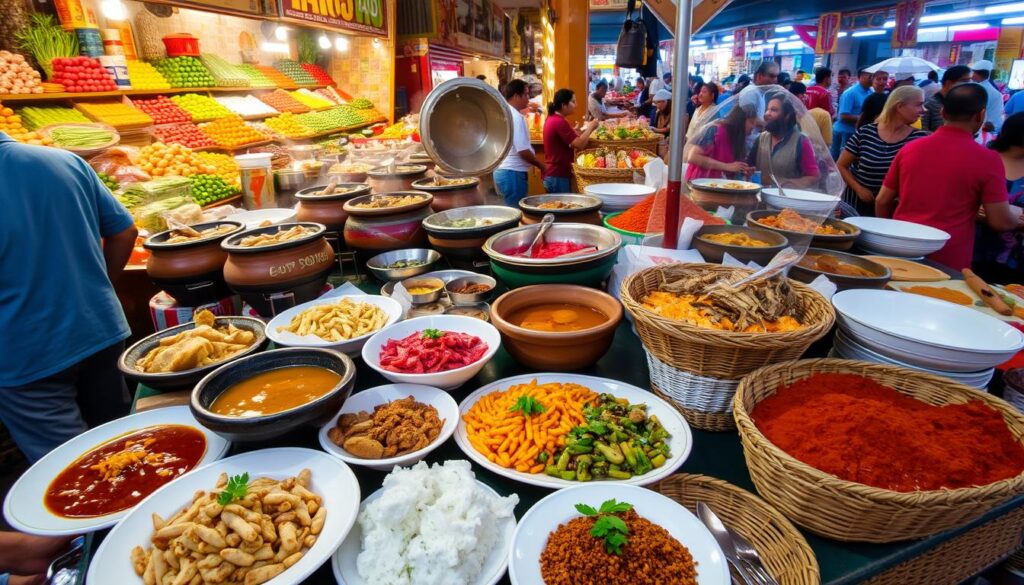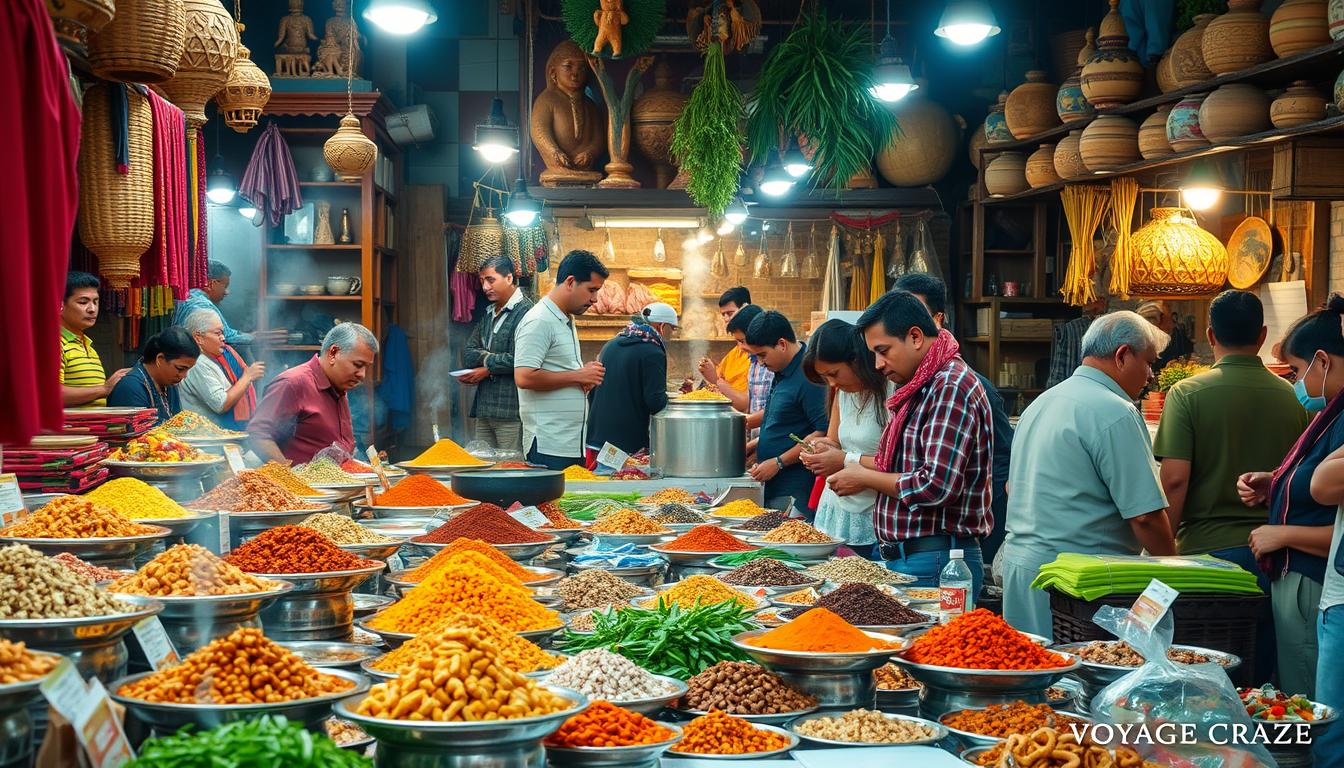Imagine being in a new place, surrounded by strange sights, sounds, and smells. Trying local culture through food is a great way to connect with the area. By tasting authentic local cuisine, you learn about the local life and make unforgettable memories.
Food is key in culture, bringing people together. Whether it’s mole in Mexico or street food in Thailand, local culture through food shows a country’s history and values. By enjoying authentic local cuisine, you learn more and have a richer travel experience.
Key Takeaways
- Experiencing local culture through food can create lasting memories and a deeper understanding of the local way of life.
- Trying authentic local cuisine can provide insight into a country’s history and cultural values.
- Food plays a fundamental role in culture, facilitating community and connection among people.
- Engaging with local foods can enhance cultural understanding and provide a more meaningful travel experience.
- 75% of respondents stated that trying a new cuisine inspired them to explore the food culture of that region further.
- Sharing meals is a universal experience that transcends linguistic and geographic barriers.
- Culinary tours and cooking classes can provide immersive experiences that enhance understanding of different global cultures through food.
Understanding the Connection Between Food and Culture
Food is key in forming cultural identity, with culinary traditions passed down through generations. The bond between food and culture is deep and complex. Food brings people together, creating a sense of community. Experts say, “Food brings people together. It brings cultures together.”
The importance of food in cultural identity is clear in food storytelling. For instance, Irish colcannon (mashed potatoes with kale and onions) is a beloved dish. It’s often enjoyed at family gatherings and special events.
The Role of Food in Cultural Identity
- Food is a symbol of cultural heritage and tradition
- Food brings people together and fosters a sense of community
- Food is a way to share stories and pass down recipes
By grasping the link between food and culture, we value culinary traditions and food storytelling. They shape our identities and communities.
Exploring Local Markets
Traveling to a new place is exciting, and visiting local markets is a great way to dive into the culture. These markets are filled with regional dishes and give a peek into the cultural gastronomy of the area. You can find everything from fresh produce to local crafts, making markets a treasure trove of unique experiences and tastes.
Places like the Bury Market in Lancashire, England, are famous for their black pudding. The Luang Prabang Morning Market in Laos is known for vendors selling rice for alms giving. In Bangkok, you can find a variety of regional dishes, including Pad Thai, which shows the city’s culinary heritage.
Going to local markets is a fantastic way to try new foods and meet local vendors. It’s a chance to learn about their customs and traditions. Research shows that about 75% of tourists who visit markets feel more connected to the local culture. With over 150 types of local produce and food items available every day, markets are a must-see for anyone wanting to experience the real cultural gastronomy of a place.

- Sampling local delicacies and trying new flavors
- Interacting with local vendors and learning about their customs and traditions
- Supporting local artisans and small businesses
- Gaining a deeper understanding of the local culture and cultural gastronomy
Exploring local markets is a key part of any travel experience. It offers a unique and authentic look into the regional dishes and cultural gastronomy of a destination.
| Market | Location | Specialties |
|---|---|---|
| Bury Market | Lancashire, England | Black pudding |
| Luang Prabang Morning Market | Laos | Rice for alms giving |
| Local markets in Bangkok | Bangkok, Thailand | Pad Thai and other regional dishes |
Participating in Culinary Tours
Exploring traditional food experiences helps us understand a place’s local food history. Culinary tours let you dive into local cuisine. You learn about ingredients, cooking methods, and the cultural value of dishes.
These tours are a chance to meet local chefs and cooks. You’ll discover the stories and traditions behind the food. For example, in Italy, you can learn how pasta is made and the role of family recipes in Italian cooking.
About 70% of travelers see local food as a key part of their trip. Culinary tours offer a way to experience local food and support the local economy. They can even boost local economies, making up to 25% of travel spending in some places.
Cooking Classes and Workshops
Diving into local food culture lets you taste the real flavors and culinary traditions of a place. Cooking classes and workshops are a special way to learn about local dishes and improve your cooking skills. With more people focusing on healthy eating, these classes are getting more popular.
These classes are for all skill levels, from beginners to experts. You’ll learn new cooking methods, ingredients, and recipes. Plus, you’ll have fun cooking with others. About 70% of people say they enjoy cooking more when they’re with friends or family.
Moreover, 80% of those who take cooking classes say they’re more likely to cook healthy meals at home. This shows how cooking classes can help you eat better.

Culture Kitchen offers cooking classes that focus on real ethnic cuisines. This gives you a chance to learn about and taste different food culture and culinary traditions. These classes are taught by skilled chefs or home cooks in places like community kitchens, restaurants, or private homes.
By joining cooking classes and workshops, you can make unforgettable memories. You’ll also understand the local cuisine better and learn new skills to share with your loved ones.
| Benefits of Cooking Classes | Percentage of Participants |
|---|---|
| Increased confidence in cooking skills | 60% |
| Formation of lasting culinary friendships | 50% |
| Healthier eating habits | 80% |
Street Food: A Taste of Everyday Life
Street food is a fantastic way to dive into local culture and try new dishes. By exploring popular street foods worldwide, following safety tips, and understanding their stories, travelers can truly grasp the local food scene.
Popular Street Foods Around the World
Some top street foods include:
- Tacos al pastor and elote in Mexico
- Skewers of grilled meats and pad thai in Thailand
- Takoyaki and yakitori in Japan
- Pho and banh mi in Vietnam
These dishes showcase the authentic local cuisine and regional dishes found in each country.
Safety Tips for Trying Street Food
To enjoy street food safely, follow these tips:
- Choose vendors with lots of customers
- Avoid raw or undercooked meat and seafood
- Drink bottled or filtered water
By doing this, travelers can safely enjoy the local street food.
Why Street Food Tells a Story
Street food shares stories of local culture and history. It reflects the authentic local cuisine and regional dishes passed down through generations. Trying street food lets travelers understand the local way of life and appreciate unique flavors and traditions.
| Country | Popular Street Food |
|---|---|
| Mexico | Tacos al pastor, elote |
| Thailand | Skewers of grilled meats, pad thai |
| Japan | Takoyaki, yakitori |
| Vietnam | Pho, banh mi |
Food Festivals and Cultural Celebrations
Diving into cultural gastronomy is a fantastic way to get to know a place. Food festivals and cultural events let you try new dishes and meet locals. They’re a chance to learn about the local food scene and its importance.
Some famous food festivals are Oktoberfest in Munich, La Tomatina in Buñol, and the Harbin International Ice and Snow Sculpture Festival. These events highlight local food and offer a chance for cultural sharing. For instance, the traditional food experiences at these festivals reveal the history and cultural value of certain dishes.
Here are some perks of going to food festivals:
* They help local communities economically
* They foster cultural exchange and appreciation
* They offer unique food experiences
* They support local farmers and artisans

In summary, food festivals and cultural events are great for experiencing cultural gastronomy and traditional food experiences. By attending, travelers can better understand the local food culture and its role in the community. They also help local economies and promote cultural exchange.
| Festival | Location | Description |
|---|---|---|
| Oktoberfest | Munich, Germany | World’s largest beer festival, attracting millions of attendees |
| La Tomatina | Buñol, Spain | Festival where participants throw tomatoes at each other |
| Harbin International Ice and Snow Sculpture Festival | Harbin, China | Festival featuring ice and snow sculptures, as well as local cuisine |
Dining Etiquette Across Cultures
Exploring local food history means learning about different dining customs. This knowledge enriches your dining experience. It lets you enjoy the food storytelling in each dish. For example, some cultures frown upon eating with your hands, while others see it as normal.
In many Asian cultures, using chopsticks is key. But, don’t stick them upright in rice, as it’s seen as rude. In contrast, in some African and Indian cultures, eating with your hands is common. But, always use your right hand, as the left is considered unclean in some traditions.
Here are some important dining etiquette tips:
- In Japan, waiting for the host to start eating shows respect.
- In India, an empty plate means you appreciated the meal.
- In China, a little food left on your plate shows the host provided enough.
By respecting these cultural differences, you can enjoy your meals more. You’ll also appreciate the rich local food history and food storytelling behind each dish.
| Culture | Dining Etiquette |
|---|---|
| Japanese | Wait for the host to begin eating |
| Indian | Leave an empty plate to show appreciation |
| Chinese | Leave a small amount of food on your plate |
Enjoying Home-Cooked Meals
Trying culinary traditions helps you understand local culture and taste new foods. Home-cooked meals let you enjoy authentic local cuisine. You also learn about the history and cultural importance of dishes.
Studies show home-cooked meals can make you eat healthier. But, many struggle to find time or money to cook. The agriculture sector benefits from home cooking, as it encourages buying local, fresh ingredients from farmers.
Some examples of culinary traditions include:
- Cajun cuisine, which shows a mix of cultural influences
- Canadian Acadian fricot, which is quite different from Cajun gumbo
- Traditional dishes in diaspora communities, which highlight how food is a key cultural trait for displaced people
Family gatherings and home-cooked meals are key to keeping family bonds strong. For example, Feng Walkup’s family runs six Chinese restaurants in the U.S. They see food as a big part of their cultural heritage.
By enjoying home-cooked meals and exploring authentic local cuisine, travelers can really get to know the local food culture and culinary traditions. This experience can be even better by finding host-family experiences, understanding the benefits of shared meals, and learning the stories behind family recipes.
| Cultural Influence | Traditional Dish | Significance |
|---|---|---|
| Cajun | Gumbo | Unique blend of African, Spanish, and Indigenous ingredients |
| Canadian Acadian | Fricot | Significant difference from Cajun gumbo, showcasing geographical and cultural impact |
Capturing Your Culinary Journey
Travelers can capture their culinary journey in many ways. They can document their food experiences and share them with others. This lets them relive their adventures and inspire others to try new foods.
Exploring regional dishes and cultural gastronomy helps travelers understand local cultures. It also creates lasting memories. Every destination offers a unique taste experience.
From Asia-Pacific’s street food to Europe’s Michelin-starred restaurants, each place has its own flavors. Travelers can join food festivals, take cooking classes, and talk to local vendors. This way, they dive into the heart of cultural gastronomy and find the real tastes of each area.
Every experience, from Mumbai’s dabbawalas to Latin America’s street markets, adds to the rich tapestry of regional dishes and local traditions.
Documenting Your Food Experiences
Documenting food experiences is easy. Just take photos and share them on social media or write about them in a blog. It’s a great way to relive memories and share them with others.
By capturing the essence of cultural gastronomy and regional dishes, travelers can relive their adventures. They can also plan new ones, always looking to explore and discover the world’s diverse flavors.
Sharing Your Discoveries with Others
Sharing culinary discoveries is a great way to connect with others. Through social media, blogs, and food-focused platforms, people can share their experiences and stories. This creates a global community of culinary explorers.
By embracing the diversity of regional dishes and cultural gastronomy, travelers can deepen their appreciation for local cultures. This enriches their own culinary journey.







